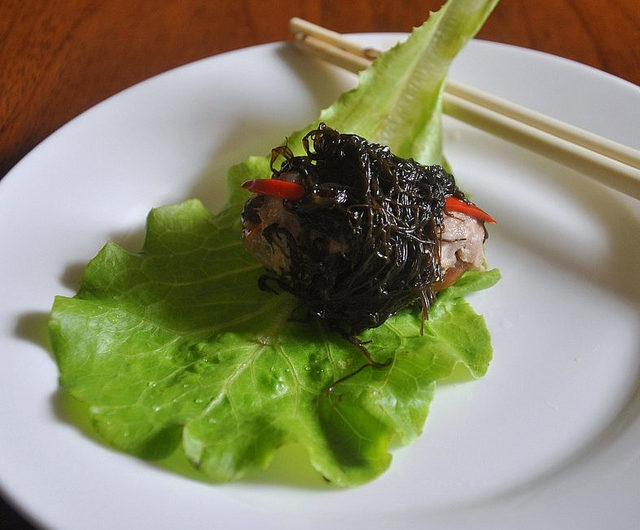You can dry oysters? Of course! Dried oysters and scallops are common in China, where they are used to add a flavor punch to soups, sauces and other dishes. They can be rehydrated, stir fried, braised, ground up and more. At this time of the year, near Chinese New Year, dried oysters are considered one of the most auspicious foods you can eat. In Chinese, they sound like the phrase for “happy events” (hoe see), so eating them is said to bring good tidings for the future.
One of the most popular Chinese New Year’s dishes is Hoe See Fat Choy. In this traditional dish, dried oysters are braised and then covered with a black moss known as hair seaweed. The name of the dish is a homophone for “happy events and prosperity,” and it’s also similar to Gong Hei Fat Choy, the traditional New Year’s greeting. It doesn’t hurt that the dish is pretty tasty too.
In New York’s Chinatown at this time of the year, many retailers will have large bins of dried oysters on display, carefully graded by size and origin. One of the best places to pick up dried ingredients is Kam Man Food Products at 200 Canal St. Or, check out Po Wing Ho Food Market at49 Elizabeth Street, a specialty dried goods store. Look for relatively plump, unbroken dried oysters for the best results.
Hoe See Fat Choy (Dried Oysters with Hair Seaweed)
Adapted from Hungry Hungry
Serves 4-6 as an appetizer
12 dried oysters, soaked for 2 hours
1 t vegetable oil
2 slices of fresh ginger
1½ t soy sauce, divided
8 oz ground pork (can substitute minced shrimp or fish paste)
½ cup dried black moss (fatt choi), soaked and rinsed until grit-free
Red chili or bell pepper strips
1 T oyster sauce
½ t salt, or more to taste
1 t sesame oil
½ t sugar (optional)
½ T cornstarch + 3/4 cup chicken stock
Lettuce leaves for plating
Clean the dried oysters by soaking them in water. Pour out any sediment at the bottom and pat dry. Add 1 t vegetable oil to a frying pan or wok, and stir fry the oysters, ginger and 1/2 t soy sauce for about 3 minutes over medium heat, until the oysters are dry. Remove from heat to cool.
Wrap each oyster with ground pork, then wrap the fatt choi around the meat-covered oyster. Add a strip of red chili or pepper underneath the fatt choi for color. Put oysters on a greased steaming plate or in a steamer basket, and steam 15 minutes.
Put the oyster sauce, remaining 1 t soy sauce, sesame oil and sugar into a small saucepan and heat. Add the cornstarch and chicken broth mixture, stirring well, until the sauce turns clear and shiny. If too thick or thin, add more stock or cornstarch solution. Season with salt and white pepper to taste.
Arrange lettuce leaves on the serving plate, and place the oysters on top. The oysters can be served with each one wrapped by a lettuce leaf. Pour the sauce over the oysters and serve immediately.
